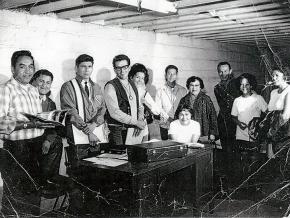1968: The rise of the Red Power movement
celebrates the anniversary of the formation of the American Indian Movement 50 years ago and the revitalization of resistance to U.S. settler-colonialism as part of SW’s series on the revolutionary year of 1968.
IN JULY 1968, the American Indian Movement (AIM) was founded in Minneapolis and became the organizational expression of the Red Power movement.
It was three months after Black uprisings shook cities across the country in the wake of Martin Luther King’s assassination, two months after the massive general strike in France, and a month before the brutal repression of anti-Vietnam war protests in Chicago outside the Democratic National Convention.
When we talk about the radicalization that happened in the 1960s and 1970s, we often forget about AIM and the Red Power movement, which were outgrowths of both centuries of resistance to settler-colonialism and the revolutionary fever of 1968.
On the 50th anniversary of founding, and in a time of renewed levels of Native resistance, it’s important to tell this story.
From Wounded Knee to “Termination”
On December 29, 1890, the 7th U.S. Cavalry killed at least 150 people — some estimate as many as 300 — at Wounded Knee, South Dakota, now located on the Pine Ridge Indian Reservation.

Many historians and Natives saw Wounded Knee as the turning point after a long fight against relentless U.S. capitalist expansion westward. The massacre is often cited as marking the end of the Indian Wars and the start of a full assimilation policy that would last until the 1970s.
But while Wounded Knee was a historic atrocity, the passage of the Dawes Act of 1887 marked the start of disastrous policy of forced assimilation. It systematically reduced the land held by Natives in the West, and attempted to integrate them into American capitalism by undoing any notion of collective ownership and “giving” 160 acres to each head of household.
One of the law’s most important provisions was that the surplus land was made available for settlers, railroads, corporations and national parks.
This time saw the forerunner of Donald Trump’s border policy of separating immigrant children from their families. Many Native children were ripped from their homes and sent to Indian boarding schools, which aimed to rid the children of their language and culture and teach them a trade to make them useful cogs in the U.S. economy.
Eventually, Franklin Delano Roosevelt’s “New Deal” government was pressured to pass the Indian Reorganization Act of 1934, which ended the Dawes Act and finally gave back some level of sovereignty to Indians by officially “creating” tribal government that were elected by the tribe. Tribal constitutions, however, had to be approved by the federal government and the constitutions could not contain any form of traditional governance.
The Conditions that Gave Rise to Red Power
By the 1950s, many American Indians lived either on extremely impoverished Indian reservations or within urban centers that were often referred to as Red Ghettos.
Socialist Worker contributors remember the great struggles of the revolutionary year of 1968 — and the lessons they hold for today.
1968: A Revolutionary Year
1968: The year that changed everything
1968: Tet and the watershed in Vietnam
1968: When King’s murder set off the uprisings
1968: Revolution reaches the heart of Europe
1968: A revolt blooms behind the “Iron Curtain”
1968: SDS and the revolt of the campuses
1968: The rise of the Red Power movement
1968: A war on dissent in the streets of Chicago
1968: Women’s liberation takes the stage
1968: The massacre in Tlatelolco
1968: The Nixon backlash and the “silent majority”
1968: The strike at San Francisco State
Natives had always come to cities for work, but this migration started to dramatically increase in 1953, when Congress passed House Concurrent Resolution 108, which called for the end of reservations and federal services and protections “as rapidly as possible.”
The policy of “termination,” as it was known, was aimed at total assimilation — and allowing the U.S. government to eliminate any type of land claim or treaty rights and finally end its “Indian Problem.”
Officials chose Native nations that they considered to be the most “advanced,” eliminated their reservations and federal relationship to Washington, and handed over jurisdiction to the state. The idea of nation-to-nation relationship and treaty rights would be abolished.
The Menominee Nation in northern Wisconsin was the first tribe to be terminated. It fell under the authority of the state, as though it were simply a county without any national identity. Menominee land became easier to sell and privatize so the county could maintain a tax base.
After the policy was implemented, the Menominee were devastated. If the federal government had its way, termination was going to be imposed on every other Native nation within the United States.
As part of the termination policy, one-way bus tickets were given to Natives to leave their reservations with the promise of good jobs, resulting in a influx of Natives into cities like Minneapolis, Milwaukee, Chicago, Seattle, Portland and San Francisco.
From 1960 to 1970, the percentage of Natives living in urban areas nearly doubled — from 28 to 44 percent. Today, 78 percent of Natives live off reservations and 72 percent live in cities or suburban areas.
This was the Indian version of the Great Migration of African Americans from the South to the North 100 years ago, except in this case, it was official government policy.
For the U.S. government, termination turned out to be a double-edged sword. It weakened Native communities, but also brought thousands of Indians together in cities, creating a pan-Indianism that hadn’t existed at least since Tecumseh’s efforts in the early 1800s to build multination resistance to Western expansion.
In cities and on reservations, American Indians faced racial profiling from the police and were one of the most disproportionately represented groups in prison. In 1968, at the time of AIM’s founding, Indians were about 10 percent of the population of Minneapolis and 70 percent of the city’s jail population.
Many of the founders of AIM first met while they were in prison. Clyde Bellecourt and Eddie Benton Banai were Ojibwe inmates in 1962 at Minnesota Stillwater Prison and started reading about the civil rights movement and the Black Panthers.
Their first taste of organizing was an education program with 47 Native prisoners. As Bellecourt recounts in Peter Matthiessen’s In the Spirit of Crazy Horse, “I guess we had the first real Indian Studies Program in the country.”
Many Indians in urban centers also started to fight for health care rights, which were guaranteed to many Natives in treaty rights. At the time, you couldn’t find an Indian Health Services outside a reservation.
The Birth of the American Indian Movement
As more and more Indians became radicalized by termination, unemployment and police violence, many took inspiration from the Black Power movement to develop their own Red Power.
In July 1968 in Minneapolis, Eddie Benton Banai, Clyde Bellecourt, George Mitchell and Dennis Banks founded what they first called the “Concerned Indian Americans.” Quickly recognizing the acronym problem, they renamed themselves the American Indian Movement.
The group’s original aim was fighting police violence in the Native neighborhood of Franklin. In their book Like a Hurricane, Paul Chaat Smith and Robert Allen Warrior describe the group’s original activities:
One of the first projects of the new group was the AIM Patrol. AIM raised money to equip cars with two-way radios, cameras and tape recorders so they could monitor arrests by the police department. When the AIM Patrol heard police dispatched to certain bars or street corners, officers would be met by Indians in red jackets carefully observing their actions. AIM also became expert at providing attorneys for those arrested. It was a tactic similar to Black Panther campaigns to monitor police in Oakland, California and other cities.
AIM’s political program was murky at first, but it evolved and developed through action and organizing into calling for self-determination and liberation.
AIM chapters started springing up everywhere in the country. The organization was growing at a rapid rate. Despite this, however, it faced the issue of disconnect from reservation people. Founded mainly by Minneapolis Ojibwe people (whose homelands are close to Lake Superior in Minnesota, Wisconsin and Michigan), AIM was an urban pan-Indian that didn’t have roots on reservations.
That changed dramatically in February 1972 after the murder of a Lakota man named Raymond Yellow Thunder in Gordon, Nebraska.
Gordon was a small town near the Pine Ridge Reservation. As in many reservation border towns, relations between Indian and white people were extremely strained. It wasn’t uncommon to hear people use the R-word and talk about the difference between “good” Indians and “bad” Indians.
That was the atmosphere in which Raymond Yellow Thunder was beaten to death by Melvin and Leslie Hare — who were charged only with assault and battery and released without bail. Yellow Thunder’s family in Pine Ridge sought assistance from both the tribe and the Bureau of Indian Affairs (BIA), but heard nothing.
That’s when the family turned to AIM, which brought caravan after caravan to Gordon alongside the Oglala Lakota people. AIM demanded justice for the murder of Yellow Thunder. Russell Means, who was Oglala Lakota, but grew up in the Bay Area, helped bridge the gap between AIM and the Lakota people in Pine Ridge.
This unexpected response by Indians inspired people all around the country and forced Gordon authoroies to impose higher charges and convict the Hare brothers.
Gordon was a turning point for AIM, which became a trusted organization to traditionals on Pine Ridge and around the country. AIM’s success no doubt frightened the government because it had shown the ability to bring together people who had been intentionally separated: urban and reservation Natives.
After its successful campaign in Gordon, AIM was emboldened and quickly put itself on the national map, bringing the issue of Indian liberation to the mainstream.
In November 1972, the group organized the Trail of Broken Treaties, in which more than 500 American Indians drove across the country to D.C. to discuss the treatment of Indigenous people with the BIA.
AIM developed a 20-point plan, including the restoration of Indians’ treaty-making authority (ended by Congress in 1871), abolition of the BIA (reminiscent of current calls to abolish ICE), and that all Indians should be governed by treaty relations. Activists kicked the BIA out and occupied the building for a few days on the eve of the 1972 presidential election.
AIM was also part of campaigns against racism in and around Indian Country in places like Rapid City, South Dakota. It called for better housing and continued its campaign against police brutality.
The Occupation of Wounded Knee
AIM’s most memorable action was the 71-day occupation of Wounded Knee in early 1973. As I wrote in a 2013 article about the occupation for SW:
In the 1970s, the Pine Ridge reservation, where Wounded Knee is located, was run like a Latin American dictatorship.
The U.S. government would funnel money to Dick Wilson, the tribal council president, who oversaw the reservation with an iron fist. Supporters of the radical AIM were hunted down by the Guardians of the Olgala Nation (GOON) squad, ending in numerous gun battles. The GOON squad worked closely with the FBI and the Bureau of Indian Affairs.
Wilson was so unpopular that reservation residents formed the Oglala Sioux Civil Rights Organization (OSCRO) to impeach him. Petitions were filed — one even had more signatures than the number of votes Wilson got in the preceding election. Blatantly showing his corruption, Wilson personally presided over the impeachment hearing and insured that it failed to remove him.
In response, residents appealed for help to AIM, which brought 300 armed Oglala Lakota and AIM activists to Wounded Knee, took over the church and trading post, blocked all the roads, took several white hostages (who in fact were there willingly) and declared it a liberated territory.
The demands were simple: get rid of Dick Wilson and have the federal government investigate treaties. But the government was worried that Wounded Knee would become an example that others would follow. A high-ranking BIA official expressed alarm over his view that Wounded Knee had “crystallized a revolutionary movement in the United States.”
Instead, the government response was with overwhelming force, as hundreds of FBI agents, federal marshals, BIA police and Dick Wilson’s GOON squad surrounded Wounded Knee.
By the end of the occupation, two American Indians, Buddy Lamont and Frank Clearwater, were killed and several others were wounded.
As the FBI escalated its attack on AIM, the occupation became harder and harder to sustain. With no electricity, and running water and supplies dwindling, the occupation pushed people to their limits. The occupation ended on May 8. The FBI came in and disarmed and arrested 120 people. However, many people had snuck out the night before, evading arrest.
Repression and Decline
AFTER THE occupation of Wounded Knee, AIM’s prominence started to diminish as the group suffered from two tactics of government repression.
First, the FBI’s COINTELPRO program infiltrated AIM and started to create a culture of paranoia and suspicion. It later emerged that Douglass Durham, the group’s security director and often Dennis Banks’ personal bodyguard, was an FBI informant.
The government shamefully framed Leonard Peltier for the murder of two FBI agents in a 1975 shootout at Pine Ridge, even as the FBI admitted that it did not know who killed the agents and was more concerned about putting Peltier behind bars.
Peltier was up for parole in 2009, but Barack Obama refused to pardon or commute his sentence. He is still serving two life sentences.
The government’s second tactic against AIM was to force those arrested at Wounded Knee to go through long drawn out court cases that the government couldn’t win but that would fatigue and bankrupt the organization. Across the country, AIM members were brought up on minor charges, but would still have to go to court and fight tooth and nail, though the cases often got thrown out. It was meant to bankrupt the organization.
The repression compounded internal divisions and debates. AIM’s leadership was male-dominated, with members like Dennis Banks and Russell Means the group’s public face.
Members like Madonna Thunderhawk and Janet McCloud saw the need for Native women to start their own organization, and formed Women of All Red Nations in 1974 to fight for American Indian women health, against mass sterilization of women and against racist mascots and culture appropriation.
Among their many achievements, AIM and the Red Power movement overturned the termination policy — including restoring the Menominee reservation — and forced the government to pass legislation that promoted self-determination.
The movement’s legacy lives strong through Indian Country, where you will now see countless hats and shirts that say “Native Pride” or “Native and proud of it.”
However, AIM’s goal of liberation is far from being met. Natives are still being targeted by the police. According to the Center on Juvenile and Criminal Justice, Native Americans only represent 0.8 percent of the population, but are 1.9 percent of those killed by police. Indians are also disproportionately represented in prison, and treaty rights are still an important struggle.
As we see a wave of Indigenous resistance on a scale not seen since the 1970s, with the rise of Idle No More in Canada, fights against pipelines at Standing Rock and countless other locations and the #NativeLivesMatter movement, its vital for us to learn the radical history of AIM.
The best way to honor that history is to continue to resist and fight racism and discrimination while calling on the U.S. for reparations and self-determination — and to put forward a vision of socialism and Native liberation that ends the exploitation of the earth and the destruction of Indigenous land, and puts the fight against capitalism and settler-colonialism at the core of our resistance.


